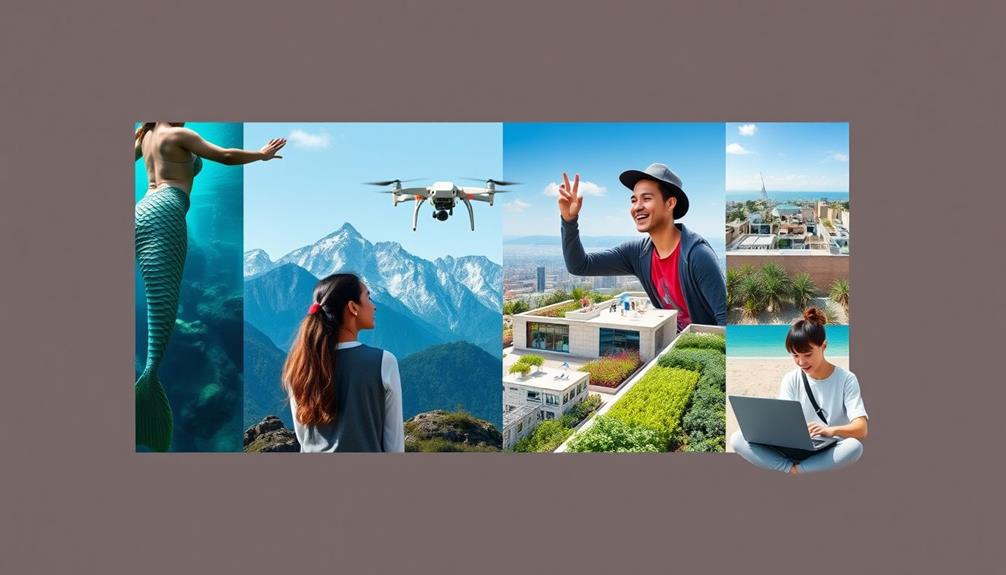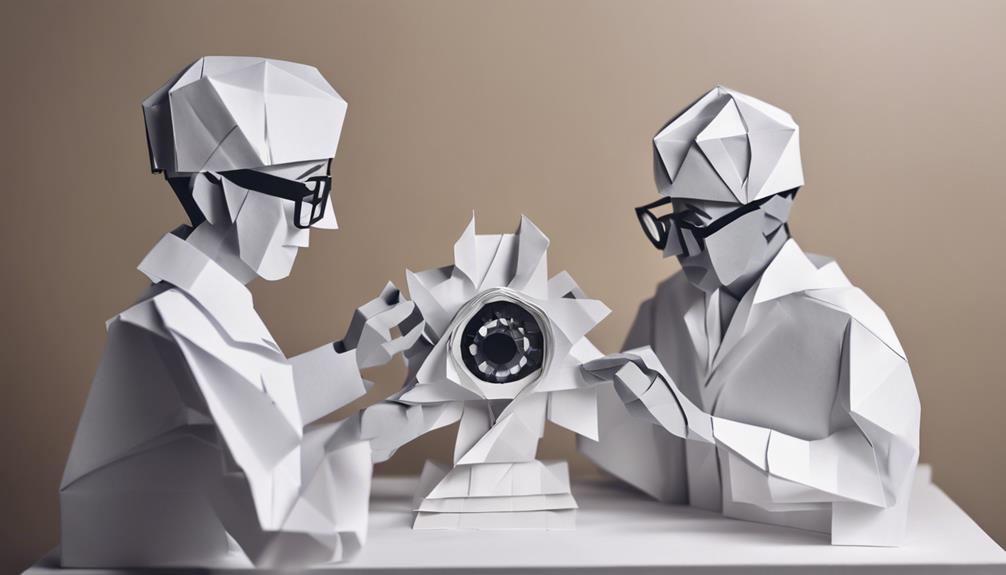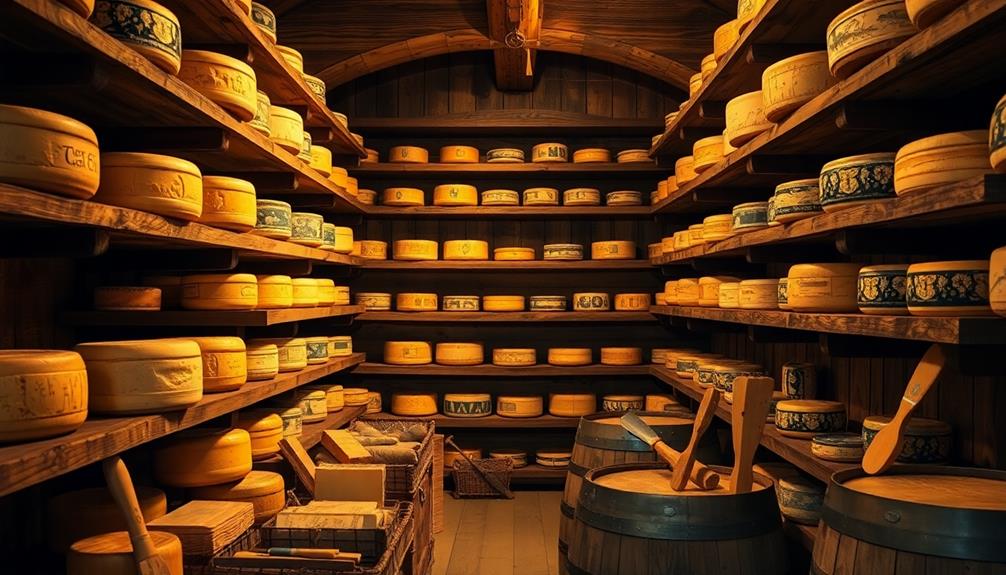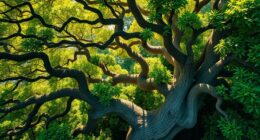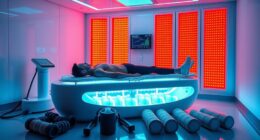Indonesian textiles can truly elevate your interior design with their bold colors and intricate patterns. These pieces, crafted using traditional techniques like batik and ikat, add a vibrant cultural touch to any space. Imagine bright throw pillows or stunning wall hangings that not only enhance the aesthetic but tell stories of rich heritage. You can mix these textiles with modern decor to create a unique atmosphere full of visual intrigue. Incorporating sustainable fabrics like cotton and silk also supports local artists. Want to discover how to flawlessly integrate these enchanting pieces into your home?
Key Takeaways
- Indonesian textiles feature vibrant colors and intricate patterns, adding bold visual interest to any interior space.
- Techniques like batik and ikat showcase traditional craftsmanship, enhancing the cultural authenticity of your decor.
- Layering different textures and patterns from Indonesian textiles enriches the tactile experience and creates a cohesive design.
- Sustainable natural fibers and dyes promote eco-friendly practices while supporting local artisans and communities.
- Mixing modern and traditional textiles creates an inviting atmosphere, allowing the unique qualities of Indonesian fabrics to stand out.
Key Characteristics of Indonesian Textiles

Indonesian textiles are a vibrant blend of culture and craftsmanship, making them stand out in the world of interior design. These textiles are famous for their vibrant colors and intricate patterns that tell stories of the region's rich cultural heritage. Techniques like batik and ikat are central to their uniqueness.
With batik, artisans use wax-resist dyeing to create detailed designs, a process that requires hours of meticulous work, showcasing their skill and dedication. Traditional artistry in masks offers a similar appreciation for craft, as each piece is a demonstration of the region's cultural narratives.
Ikat, on the other hand, features bold, blurred patterns achieved through a labor-intensive method of binding and dyeing yarns before weaving, resulting in stunning handmade pieces.
Crafted from natural fibers such as cotton and silk, these textiles not only enhance aesthetic appeal but also promote sustainability and eco-friendliness. The use of these materials reflects a commitment to preserving the environment while providing luxurious, tactile elements for your home.
Vibrant Color Palettes

When you think about Indonesian textiles, vibrant colors immediately come to mind, each hue carrying significant cultural meaning.
These textiles often feature intricate patterns that reflect traditional craftsmanship, making them not just decorative but also a narrative of heritage.
You can create stunning color combinations that not only energize your space but also promote harmony with natural materials.
By understanding these palettes, you'll enhance both the aesthetic and emotional atmosphere of your home.
Incorporating elements like Indonesian Decorative Pillows can further elevate your interior style.
Cultural Significance of Colors
Colors in Indonesian textiles burst with vibrancy and meaning, creating a dynamic visual experience that resonates deeply with cultural heritage. Each hue carries cultural significance, making these textiles not just beautiful but also symbolic.
These rich colors are often mirrored in other Indonesian art forms, such as the intricate designs of Indonesian decor masks, which also tell stories through their bold aesthetics.
Here are three key aspects of the colors used in Indonesian textiles:
- Symbolism: Colors like red symbolize courage and power, while blue represents calmness and tranquility. These meanings enrich the narrative behind each piece.
- Traditional Dyeing Techniques: Techniques like batik showcase vibrant colors through wax-resist methods, resulting in intricate patterns that tell stories and reflect cultural narratives.
- Bold and Earthy Tones: The combination of bold colors and earthy tones energizes spaces and enhances aesthetic appeal. These textiles serve as perfect accent pieces, transforming your room with warmth and vibrancy.
Incorporating Indonesian textiles into your interior design not only adds beauty but also infuses your space with cultural depth.
Whether it's cushions, curtains, or wall hangings, these vibrant color palettes elevate your decor and create a unique atmosphere that celebrates Indonesia's rich heritage.
Color Combinations and Harmony
A vibrant color palette can transform any space, and Indonesian textiles offer an array of options that energize your interior design. With rich reds, deep blues, and earthy tones, these textiles reflect the country's cultural heritage while adding energy to your home. When you incorporate batik prints, you're not just adding color; you're introducing intricate designs that enhance your existing color combinations and overall aesthetic appeal.
Additionally, the expert tropical design offered by Mahallati Interiors can further elevate your space by integrating these textiles into a cohesive design concept.
Layering textiles, like ikat and batik, allows you to create a dynamic visual experience while maintaining a cohesive look. These bold hues can serve as focal points, drawing attention and sparking conversation among guests.
By mixing and matching these vibrant color palettes, you can express your personality and creativity, achieving a personalized interior design that feels uniquely yours.
Don't shy away from experimenting with different patterns and colors. The versatility of Indonesian textiles makes it easy to coordinate colors that resonate with you.
Traditional Techniques and Craftsmanship

Intricacy defines the world of Indonesian textiles, where traditional techniques like Batik and Ikat reveal a deep cultural heritage.
These methods showcase the remarkable craftsmanship of artisans, who pour their skills and stories into every piece. The beauty of these textiles is further enhanced by the vibrant colors and intricate designs, much like the Face Indonesian Decor Mask, which represents rich Indonesian cultural heritage.
You'll appreciate how these intricate dyeing processes facilitate the unique design of each textile.
Here are three key aspects of these traditional techniques:
- Batik: This wax-resist dyeing method, dating back to the 6th century, involves applying wax to fabric before dyeing. The result is vibrant patterns that reflect cultural symbolism, recognized by UNESCO as a Masterpiece of the Oral and Intangible Heritage of Humanity.
- Ikat: In this technique, threads are bound and dyed before weaving, creating blurred patterns unique to each piece. The handmade nature ensures no two textiles are exactly alike, highlighting the artisan's skill.
- Sustainable Practices: Many artisans utilize natural dyes and materials, promoting environmental responsibility while supporting local economies.
These traditional techniques not only produce beautiful textiles but also preserve a rich cultural heritage, making them perfect for elevating your interior design.
Incorporating Batik Into Decor

When you think about incorporating batik into your decor, it's important to understand the unique patterns that make each piece special.
Balinese interior design concepts often emphasize natural materials and earth tones that beautifully complement the vibrant colors of batik. You can creatively apply batik through items like pillowcases, tablecloths, or wall art, adding vibrant colors and cultural richness to your space.
Batik Patterns Explained
Batik's vibrant patterns can transform your interior spaces into reflections of rich Indonesian culture. These traditional textiles feature intricate designs that often draw inspiration from nature and cultural symbolism, making them perfect for enhancing your home decor.
When you incorporate batik into your design, consider the following:
- Accent Pieces: Use batik textiles as focal points in your room, whether through throw pillows, wall art, or table runners. Their rich colors and detailed patterns can elevate the aesthetic appeal of any space, aligning beautifully with traditional Indonesian style home decor that emphasizes natural materials and cultural significance.
- Color Coordination: Pay attention to how batik patterns interact with your existing decor. Coordinating colors guarantees a harmonious look that ties the room together.
- Artisanal Craftsmanship: Each batik piece tells a story, showcasing the unique craftsmanship of Indonesian artisans. By including these textiles, you celebrate cultural narratives in your home.
Integrating batik patterns into your decor not only adds a touch of vibrancy but also pays homage to a rich heritage.
With thoughtful placement and color coordination, you can create a cohesive and inviting atmosphere that reflects both style and cultural appreciation.
Creative Batik Applications
As you explore creative ways to incorporate batik into your decor, you'll find that these vibrant textiles offer limitless possibilities for enhancing your living spaces. Batik textiles, renowned for their intricate patterns and vibrant colors, make stunning upholstery for furniture, adding a unique touch that reflects Indonesian cultural heritage.
Consider using batik in conjunction with Indonesian wedding decor ideas to create a rich, immersive environment in your home.
You can also use batik as wall hangings or framed art to create intriguing focal points in any room. This not only enriches your decor but also invites storytelling through traditional craftsmanship.
For dining and living areas, consider batik table runners and throw pillows to blend comfort with cultural authenticity, elevating the overall aesthetic.
Additionally, batik fabric can transform window treatments, such as curtains or shades, allowing natural light to filter through while showcasing beautiful patterns.
By layering batik textiles—like quilts or throws—you'll create a cozy atmosphere that celebrates the artistry and diversity of Indonesian design.
Layering Textiles for Impact
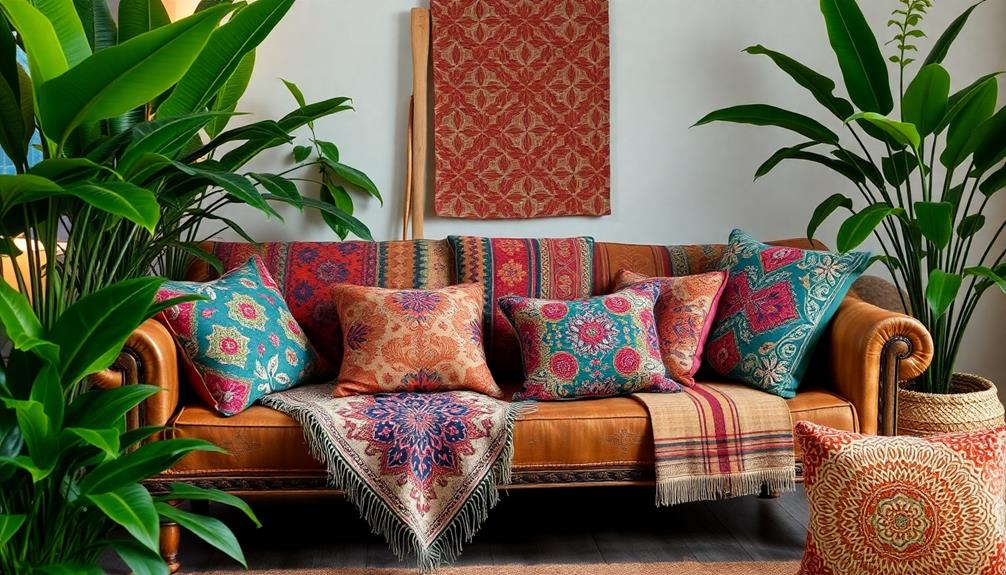
Layering textiles transforms any interior space, adding depth and visual intrigue. By incorporating vibrant Indonesian fabrics, you can create a striking environment that reflects cultural heritage while enhancing aesthetic appeal.
To complement these textiles, consider the principles of tropical contemporary house design that prioritize eco-friendly architecture and seamless indoor-outdoor flow.
Here are three key strategies for effective layering:
- Combine Various Textures: Use silk ikat pillows with woven rattan elements to add richness and warmth. This combination creates a tactile experience that invites exploration.
- Mix Patterns and Colors: Don't shy away from dynamic decor! Play with bold patterns and colors in your textiles to showcase unique artisanal pieces. This approach allows for personalization and visual interest.
- Balance Weights: Pair lightweight cotton throws with heavier wool rugs to create an inviting atmosphere. The contrast in textile weights contributes to a harmonious design.
Strategic layering not only enhances comfort but also maintains a cohesive color palette throughout your space.
Sustainable Textile Choices

Choosing sustainable textiles is essential for creating an eco-friendly interior design. By opting for Indonesian textiles like batik and ikat, you're not just enhancing your space; you're also making a responsible choice. These textiles are often crafted using sustainable methods that promote eco-friendly practices, supporting local artisans and their communities.
Additionally, traditional Indonesian housing, which emphasizes the use of local materials, reflects a deep connection to the environment and culture, aligning well with your sustainable design choices (traditional Indonesian housing).
Many Indonesian textiles utilize renewable materials such as cotton, silk, and bamboo. This choice reduces the environmental impact compared to synthetic alternatives.
Plus, the use of natural dyes enhances the authenticity of each piece, adding a unique touch to your decor.
When you choose these textiles, you're also participating in fair trade practices, ensuring that artisans receive fair compensation for their work. This support fosters economic growth in local communities, helping to preserve their cultural heritage while emphasizing sustainability.
Incorporating sustainable textiles into your interior design not only elevates your aesthetic but also aligns your choices with a commitment to the planet.
Highlighting Cultural Significance
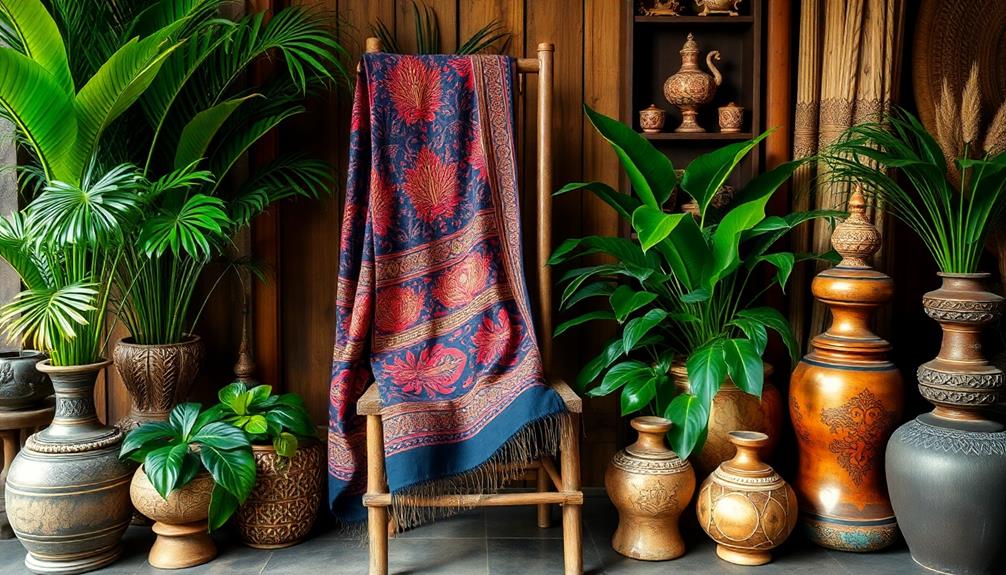
Indonesian textiles, with their vibrant patterns and rich histories, bring a unique cultural significance to interior design.
These textiles, like batik and ikat, aren't just decorative but also tell stories of local traditions, craftsmanship, and community values. Their intricate patterns reflect Indonesia's cultural heritage, making them perfect for modern spaces and complementing the natural materials often found in Balinese design aesthetics.
Here are three key aspects of their cultural significance:
- Batik Technique: Recognized by UNESCO, this labor-intensive wax-resist dyeing method produces symbolic designs that resonate with Indonesian identity and history.
- Ikat Textiles: With a history spanning over 5,000 years, ikat showcases blurred patterns that highlight the skilled craftsmanship passed down through generations, emphasizing a deep connection to the past.
- Symbolic Motifs: Traditional motifs often symbolize nature, spirituality, and community, bridging the gap between aesthetics and storytelling.
Textiles as Focal Points

Textiles serve as enchanting focal points that can transform any interior space. Indonesian textiles, like batik and ikat, are known for their vibrant colors and intricate patterns, instantly elevating your home's aesthetic. Each piece tells a story, showcasing rich cultural heritage while enhancing your decor.
By incorporating these textiles, you create stunning focal points that draw the eye and spark conversations about their origins. Batik can add depth to upholstery or act as a striking wall hanging, while ikat's unique resist-dyeing technique offers beautifully imperfect designs that stand as distinctive works of art.
Here's a quick guide to help you choose the right textile for your space:
| Textile Type | Key Features | Design Ideas |
|---|---|---|
| Batik | Rich in cultural heritage | Upholstery, decorative pillows |
| Ikat | Unique resist-dyeing | Wall hangings, table runners |
| Both | Vibrant colors, intricate patterns | Mixed with modern or bohemian styles |
Utilizing Indonesian textiles not only enhances your interior but also connects it to its cultural roots, creating an inviting atmosphere.
Mixing Modern and Traditional Styles

Blending modern and traditional styles can create an enchanting aesthetic that celebrates Indonesia's rich cultural heritage.
By mixing modern and traditional Indonesian textiles, like ikat and batik, you can achieve a unique aesthetic that complements contemporary design.
Here are three effective ways to do this:
- Bold Textiles as Focal Points: Incorporate handcrafted ikat patterns into your modern furniture or decor. This adds depth and vibrant colors, making your space more dynamic.
- Layering for Visual Interest: Combine traditional textiles with contemporary fabrics. This layering enhances rich textures and intricate patterns while maintaining a cohesive design.
- Neutral Palettes for Contrast: Utilize neutral color palettes in your modern furnishings. This allows the vibrant hues of Indonesian textiles to stand out, creating an inviting atmosphere that draws the eye.
Frequently Asked Questions
Where Can I Purchase Authentic Indonesian Textiles?
You can purchase authentic Indonesian textiles at local markets, specialized online stores, or through artisan cooperatives. Explore options like Etsy, eBay, or dedicated textile retailers to find unique, handcrafted pieces that suit your style.
How Do I Care for Indonesian Textiles?
To care for Indonesian textiles, you'll want to wash them gently by hand in cold water, avoid direct sunlight, and store them in a cool, dry place. Regularly check for pests to keep them safe.
Are Indonesian Textiles Suitable for Outdoor Use?
Indonesian textiles can captivate your outdoor space, but they're not always weatherproof. If you want to use them outside, focus on protecting them from moisture and direct sunlight to maintain their vibrant beauty longer.
What Are the Best Ways to Display Indonesian Textiles?
To display Indonesian textiles effectively, you can create a gallery wall, drape them over furniture, or use them as table runners. Experiment with layering and framing to showcase their vibrant colors and intricate patterns beautifully.
Can I Find Indonesian Textiles in Different Fabric Types?
Sure, you can find Indonesian textiles in various fabric types! Imagine a rainbow of textures, from silk to cotton. Just explore local markets or online shops, and you'll discover a treasure trove waiting for you!
Conclusion
As you explore the bold aesthetic of Indonesian textiles, you might find that their vibrant colors and rich traditions unexpectedly resonate with your personal style. Incorporating these unique pieces can transform your space into a enchanting blend of culture and modern design. So, as you layer batik and other textiles, you'll not only elevate your interior but also create a story that reflects your journey. Who knew that a simple fabric could weave together such beautiful connections in your home?

